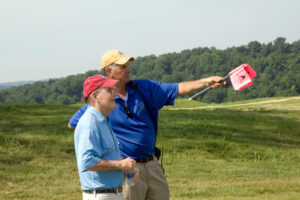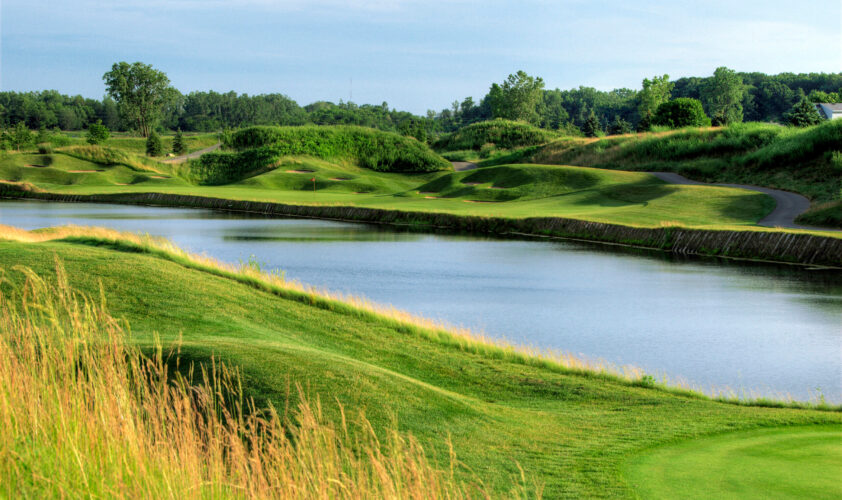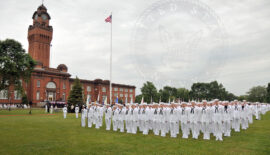Chris Lutzke worked with Pete Dye for more than 30 years, helping create some of the game’s
greatest golf courses, from The Ocean Course at Kiawah Island, site of this year’s PGA Championship,
to the world-renowned Whistling Straits, home of this year’s Ryder Cup. He’s also an acclaimed architect in his own right, having designed the Top 100 course Eagle Eye in Bath, Michigan, as well as the new 10-hole short course at Kohler, Wisconsin, The Baths of Blackwolf Run.

Lutzke worked with legendary architect Pete Dye for more than 30 years, helping build some of the world’s very best golf courses along the way.
Born in Wisconsin, the 54-year-old Michigan State alum now has his residence with his wife in French Lick, Indiana, where he helped build the formidable Dye Course at French Lick Resort.
We caught up with Lutzke recently to talk about the state of the game (and his game), his latest projects and Pete Dye’s legacy he carries on:
GOLFTIME MAGAZINE: I sure appreciate you making time today. I know you’ve got to be a very, very busy guy right now.
CHRIS LUTZKE: Well, you know, we’re down at Vero Beach (Florida), restoring or renovat- ing the Pete Dye course, Grand Harbor. We just started. We just were planting our first 10 greens today. I like to be out there telling everybody what to do, which usually screws everything up, but I just am how I am (laughs).
But it’s going pretty well.
GT: Do you get to play much?
CL: I don’t, and you know, I was in the Do- minican Republic for five years there. We renovated all the courses at Casa de Campo, and I played golf almost every day and never got below a 15 (handicap).
Right now, I’m probably in 18 or 20, if we went out today. I hate to admit that cause I eat, sleep and drink golf, but golf is hard. I’ve had a lot of back surgeries, but that’s just an excuse. My back’s pretty good right now.
You know, (I don’t know if you need to put this in writing), but I was in the Dominican Republic for all those years and it seemed like I was calling Pete Dye every other day saying, “My God this is broke or that’s broken.”
So, one day he answered the phone, and said, “Chris, don’t call me anymore.” (Laughs.) He says, “When something breaks down, I want you to play golf until the parts get there and then just go back to work.”
And I’m thinking, well, that’s the craziest thing I ever heard. But that’s what I started doing and he’d come down and we’d play golf at Teeth of the Dog, or whatever.
But one day he says, “Chris, I never met anyone that played as much golf as you have over the last five years and gotten worse.” (Laughs.)
Golf is hard.
GT: Well, you know, speaking of golf being hard, if we could talk about Whistling Straits a minute. You did a lot of the prep work for the Ryder Cup.
CL: Yeah, all of it. (Laughs.)
GT: What’s this been like for you? Where does it stand right now? Do you feel ready? I’m surprised you’re not up there tinkering right now.
CL: Yeah, you know we were doing all the Ryder Cup work for the last two years. And we were finishing up the (new 10-hole short course) Baths course, getting ready for the grand opening. And it came to a certain point, I said, “I’m thinking, guys, we should probably get out of here because everything we do requires time to heal.” And having it moved back a year was probably the best thing that could have happened.
Most of the work we did up there was for gallery movement and to try to get these people for the Ryder Cup out on the golf course.
You know they got a really good amphitheater up there on the 18th hole, but those folks are going to be pretty upset when that match gets over on hole 14, right? So, the objective was to get the people out onto the golf course, and anyone who’s ever been up there knows there isn’t a whole lot of room on that routing, so we moved an amazing amount of material.
While we were out there, we exposed a lot of the original bunkers and you know, pulled a lot of the grass out of them, and it really looks more like it did there in the 2004 PGA Championship right now than it ever has. So, it really looks good up there.
GT: You were there from the beginning, and you know how it’s kind of evolved and changed over the years. So, you think it looks more like the original intent now than it ever has?
CL: I do, yeah. We pulled a lot of that grass down and opened up the long views and exposed more sand, and it’s definitely got a little more of that Irish or Scottish feel now. Not that it was ever lacking any of that flavor (Laughs).
GT: You’ve spoken very eloquently about what The Baths meant to you. Can you elaborate on that a bit, given your relationship to Pete and Mr. Kohler? What was that like?
CL: Well, you know, I think getting that call, and that piece of property, and you know, to sit down with Mr. Kohler and for him to say, “Hey, I want this to be your vision.” …
To be able to spend that kind of money and move 160- or 170,000 yards of mate- rial on, what, 27 acres? And to come up with that and not have any restraints other than, “I want this to be like nothing anyone’s ever seen,” or something along those lines. I mean, to have that kind of a project, to have a man like that trust a kid like me … I guess I’m not a kid anymore, I’m 54 (laughs) … but it was an honor to go in there and show them what I’ve learned all the years with Pete and to get my own thoughts my own design incorporated into that development, … that was really special.
GT: I can only imagine.
CL: And I’ll say one more thing. You know I still have some of the original Pete Dye guys with me, guys like Abe Wilson.
I’m a designer now and I go out and do all this work but at the end of the day, it’s only as good as the guys making it happen. You know I get all the credit, but they’re in the background and you know any great design is only as good as the guys you’ve got putting it together.
GT: You talk about The Baths as being one of the best projects you’ve worked on, because of Mr. Kohler’s support, but it also just looks like a lot of fun. It must have been just a tre- mendous amount of fun, right?
CL: It was. It was, of course it was, and it was even fun finding some of that very unique stone out there that was from northern Wisconsin, and we somehow found it.
And Mr. Kohler was willing to pay for it because you know he named The Baths, The Baths. Before I even did a routing, he knew he wanted that to pay homage to the Kohler Company, and for you know, six months I was trying to figure out something out here that resembles these baths in our ponds. I didn’t want it to look too gimmicky because I could get funky real fast. It still needed to be something special and have a lot of identity and a lot of character. And not look like a theme park, either, because you know you make that mistake, and that phone will stop ringing quick!
So, it was a challenge. But it was fun, and I think we kind of balanced it out perfectly when everything was said and done, it’s pretty good.
GT: So along with The Baths, this really kind of feels like the short-course craze is in full swing, would you say?
CL: I think it is. I think it is the craze and they’re popping up all over the place, from Pinehurst to Bandon Dunes and down here in Florida. I mean, there’s a younger generation of golfers coming out who want to have some speakers on their golf bag and play par threes barefoot, you know?
I mean, it is what it is, what are you gonna do? Golf’s changing a little bit, and these putting courses are really something, too.
GT: Obviously we saw pretty much the entire game, having a huge uptick during the pandemic. Can you talk a little bit about the state of the game? Is this as healthy as you’ve seen it in a while?
CL: Yeah, I mean COVID’s probably done more for golf in the last 14 or 15 months than we’ve seen since the late ‘90s. I mean, everyone’s been trying to figure this out since the late ‘90s, cause we’ve seen it kind of going down, going the wrong way. But golf seems to be in a place where it hasn’t been since the late ‘80s or early ‘90s.
And I’m not saying they’re building 300 courses a year, but it’s just that the ones that are here are wanting to spend some money and do some work. Everyone’s spending money now to try to make their course a little better.
GT: You’d worked with and known Pete for what almost must seem like your whole life.
CL: It really does.
GT: What would you say — I know this is probably hard to pinpoint — but what would you say is the biggest lesson you learned from Pete?
CL: I guess what I learned most from Pete … Pete could always show up on a job site when everyone thought, you know, it was the worst day ever or the world was coming to an end, and he’d always put everyone’s mind at ease. I’ve seen him do it a thousand times. You know, let’s say your fifth hole broke off and fell into the ocean. I’m exaggerating a little bit, but Pete would come in and say, “God dang, that’s the best thing that ever could have happened to that golf hole! Now we can do this or this, since that, you know, whatever it was.”
He always had the right things to say, and every time we left a place, everybody was al- ways in a great mood. I don’t know if that’s his insurance salesman coming out of him, or he just always had a way of making people feel comfortable.
And if it was telling a story about, you know the Dominican Republic or what he did last week, or, you know, somebody he ran into, he was just a good storyteller and people really gravitated towards him and trusted him and believed in him.
And as far as design, you know, he did most of it in the field. You know, of course we did routings with topographic maps, but it was just to make sure we could fit 18 holes.
But once that routing was done, that plan was in the back seat of a pickup truck, never to be seen again. Everything was in the field.
And a lot of times it’s just taking the dozer and just making a line in the dirt, and he’d stand back there where the tees go and envision a golf hole.
He’d scratch 3 or 4 lines in the dirt there and finally he’d see it. And you know, after time I’d see it.
Most people always said they could see what he was seeing, but they’re all lying. He just had a brilliant mind. And it was a process — “The Pete Dye Process” I called it.
GT: What would you say is the biggest difference between his design style and yours?
CL: Boy, that’s a good question. You know, in the last 10 or 15 years or before he passed away, he was just as happy going in and renovating a Donald Ross course as he was building a brand-new golf course, ‘cause he always thought he knew what Ross would do. And I’ve studied and I know Ross probably as good as any of those old architects.
So, I do a lot of that same stuff and what I’ve learned over the years is it’s really easy to make a golf hole hard, or you know, difficult. The hard part is making a golf hole that anybody can play and still have fun.
And I’ve renovated a lot of stuff with Pete over the years. And now in the last two or three or four years, I get to do it on my own and I’m honored. It’s a privilege and I don’t take it for granted.
To walk out on these old Pete Dye courses, it’s pretty special, and my team feels the same way, you know. To walk a few holes when we first get here and figure out what he was thinking and to walk down those fairways and having him gone now …
He’s watching over us, I’m certain of it.
Visit crlutzke.com for more about the architect.

 ';
';
 ';
';